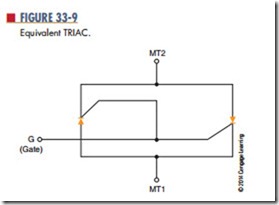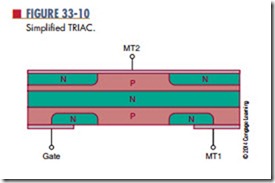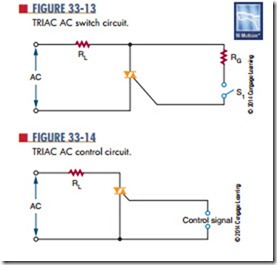TRiACs
tRiAc is an acronym for Triode AC semiconductor. TRIACs have the same switching characteristics as SCRs but conduct both directions of AC current flow. A TRIAC is equivalent to two SCRs connected in parallel, back to back (Figure 33-9).
Because a TRIAC can control current flowing in either direction, it is widely used to control application of AC power to various types of loads. It can be turned on by applying a gate current and turned off by reducing the operating current to below the holding level. It is designed to conduct forward and reverse current through the terminals.
Figure 33-10 shows a simplified diagram of a TRIAC. A TRIAC is a four-layer NPNP device in parallel with a PNPN device. It is designed to respond to a gating current through a single gate. The input and output terminals are identified as main terminal 1 (Mt1) and main terminal 2 (Mt2). The terminals are connected across the PN junctions at the opposite ends of the device. Terminal MT1 is the reference point for measurement of voltage and current at the gate terminal. The gate (G) is connected to the P–N junction at the same end as MT1. From MT1 to MT2, the signal must pass through an NPNP series of layers or a PNPN series of layers.
The schematic symbol for a TRIAC is shown in Figure 33-11. It consists of two parallel diodes connected in opposite directions with a single gate lead. The terminals are identified as MT1, MT2, and G (gate). Several TRIAC packages are shown in Figure 33-12.
A TRIAC can be used as an AC switch (Figure 33-13). It can also be used to control the amount of AC power applied to a load (Figure 33-14). TRIACs apply all available power to the load. When a TRIAC is used to vary the amount of AC power applied to the load, a special triggering device is needed to ensure that the TRIAC functions at the proper time. The triggering device is necessary because the TRIAC is not equally sensitive to the gate current flowing in opposite directions.
TRIACs have disadvantages when compared to SCRs. TRIACs have current ratings as high as 25 amperes, but SCRs are available with current ratings as high as 1400 amperes. A TRIAC’s maximum voltage rating is 500 volts, compared to an SCR’s 2600 volts. TRIACs are designed for low frequency (50 to 400 hertz), whereas SCRs can handle up to 30,000 hertz. TRIACs also have difficulty switching power to inductive loads.
Questions
1. What is the difference between a TRIAC and an SCR?
2. Describe how a TRIAC is constructed.
3. Draw and label the schematic symbol for a TRIAC.
4. What are some applications of a TRIAC?
Compare the advantages and disadvantages of TRIACs and SCRs



